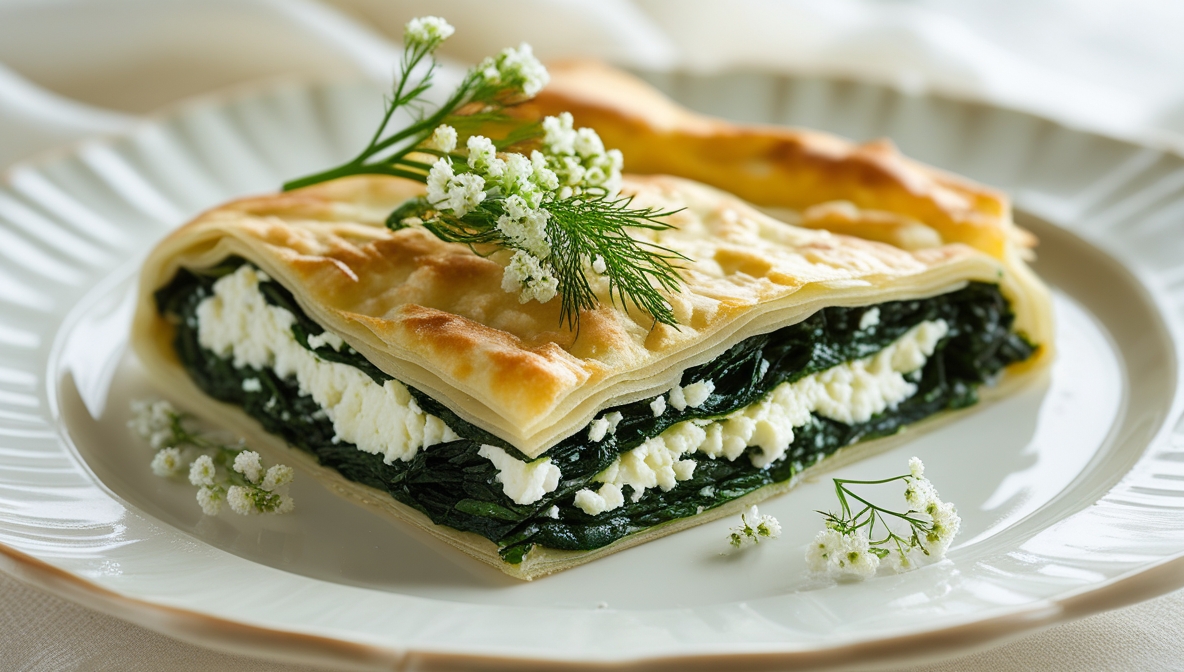Introduction
Golden, crispy, and bursting with flavor, Spanakopita is one of Greece’s most beloved traditional dishes. Known globally as Greek spinach pie, this savory pastry embodies the spirit of Greek home cooking—simple ingredients layered with love and history. It’s more than just food; it’s a piece of culture served warm.
So why is Spanakopita so adored? Its flaky phyllo crust, rich spinach and feta filling, and aromatic herbs offer a perfect balance of textures and flavors. Found everywhere—from family kitchens to bustling street stalls and elegant restaurants—Spanakopita is a true Greek classic that wins hearts across all generations.


History & Cultural Significance
Spanakopita’s origins are deeply rooted in ancient Greek and Byzantine cuisine. While spinach wasn’t widely used until after the 7th century, pies with greens, cheese, and herbs have long existed in the region. The modern version of Spanakopita likely developed during the Ottoman period, when the layering of phyllo pastry became common.
In Greek households, Spanakopita is not just a meal but a tradition. It’s served at Easter, family reunions, name days, and festivals. It symbolizes abundance, hospitality, and the comfort of home—making it a must at any Greek celebration.
Ingredients & Regional Variations
Key Ingredients:
Fresh spinach (or a mix of wild greens)
Feta cheese (crumbled)
Onions or scallions
Eggs (to bind the filling)
Fresh herbs (like dill, mint, parsley)
Olive oil
Phyllo dough (thin layers of pastry)
Regional Variations:
In Epirus, a mountainous region, locals use wild greens and leeks.
Crete has a similar pie called Kalitsounia, often with myzithra cheese.
In Macedonia, Spanakopita may be made with homemade thicker phyllo and shaped into spirals.
Modern Adaptations:
Vegan versions use tofu or cashew cheese.
Gluten-free recipes use rice paper or GF phyllo.
Spanakopita muffins and rolls are trending as easy-to-eat snacks globally.
Cooking Process & Difficulty Level

Difficulty Level:
Beginner-friendly with intermediate steps (handling phyllo requires care).
Quick Step-by-Step Guide:
-
Sauté spinach with onions until wilted. Let it cool.
-
Mix in feta, herbs, eggs, and a dash of nutmeg.
-
Layer phyllo sheets in a baking dish, brushing each with olive oil.
-
Add filling, then cover with more phyllo layers.
-
Bake at 180°C (350°F) for 40–50 minutes until golden brown.
Where to Eat Spanakopita in Greece
-
Ariston Bakery (Athens): Famous for its range of traditional pies since 1910.
-
To Koulouri tou Psyrri (Athens): A street favorite for quick Spanakopita on the go.
-
Avli Restaurant (Crete): A modern take with traditional flavors in a fine dining setting.
-
Mikres Kyklades (Naxos): Known for their homemade phyllo and local cheeses.
-
Funky Gourmet (Athens – Michelin-starred): Offers creative reinterpretations of classic Greek dishes, including Spanakopita-inspired bites.
Pairing with Drinks & Side Dishes
Drinks:
-
White wine (like Assyrtiko or Moschofilero)
-
Iced tea with lemon
-
Fresh-squeezed orange juice (for a light lunch)
-
Ouzo or Tsipouro (for a more traditional kick)
Side Dishes:
-
Greek salad (with tomatoes, cucumber, olives, and oregano)
-
Tzatziki dip
-
Lentil or chickpea soup
-
Roasted vegetables with lemon and herbs
Fun Facts & Lesser-Known Trivia
-
Spanakopita Day is unofficially celebrated by Greek communities on March 15th.
-
Some historians believe it was inspired by Persian borek, which also uses layered dough and savory fillings.
-
It’s a favorite of celebrities visiting Greece, including Tom Hanks and Rita Wilson.
-
Greek grandmothers (yiayiás) are known for their unique, secret herb mixes passed down through generations.
Health Benefits & Nutrition
-
High in iron & vitamins A, C, and K (thanks to spinach).
-
Good source of protein and calcium (from feta and eggs).
-
Can be adapted to vegan, gluten-free, or keto diets.
-
When baked with olive oil and fresh ingredients, it’s a nutritious and satisfying meal.
How to Cook It at Home (Best Spanakopita Recipe)
Basic Ingredients:
-
1 kg fresh spinach (or frozen, well-drained)
-
200g feta cheese, crumbled
-
1 large onion or 5 scallions, finely chopped
-
2 eggs
-
3 tbsp olive oil
-
Fresh dill and parsley (chopped)
-
8–10 phyllo sheets
-
Salt & pepper
Step-by-Step Method:
-
Preheat oven to 180°C (350°F).
-
Sauté onion and spinach in olive oil until wilted. Cool and drain.
-
Mix spinach with crumbled feta, eggs, herbs, salt, and pepper.
-
Brush a baking dish with olive oil. Layer 4–5 phyllo sheets, brushing each with oil.
-
Spread filling evenly. Cover with remaining phyllo sheets.
-
Tuck in the edges and score the top with a knife.
-
Bake for 45–50 minutes or until golden.
Tips for Flavor:
-
Use fresh herbs generously.
-
Don’t skip the draining step—excess water can ruin the texture.
-
Add a touch of nutmeg for extra aroma.
Global Influence & Fusion Cuisine
Spanakopita has crossed Greek borders and become a favorite in Middle Eastern, Mediterranean, and Western cuisines.
-
In the U.S., it’s a common feature at brunches and potlucks.
-
Fusion versions include Spanakopita quiche, Spanakopita empanadas, and even Spanakopita pizza!
-
It’s a highlight in vegetarian menus worldwide, praised for its flavor and simplicity.
Comparison with Similar Dishes
-
Borek (Turkey): Uses yufka (similar to phyllo), often with spinach or meat fillings.
-
Empanada (Spain/Latin America): Dough-wrapped pastries, often fried or baked with various fillings.
-
Quiche (France): Egg-based custard pie, creamier and richer than Spanakopita.
-
Saag Paratha (India): Flatbread stuffed with spiced spinach—no cheese, but similar green filling.
-
Strudel (Austria): Though sweet, strudel-style pastry resembles Spanakopita’s layers.

